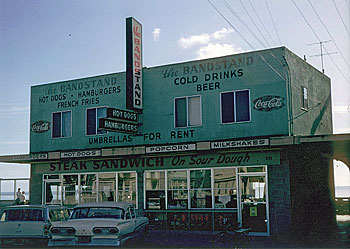In 1960, my parents bought a little cabin on the Soquel Creek, and my mother and we kids would come and spend the summer there. My Dad would come on the weekends from Sacramento. Dad bought the 600 square feet cabin for $28,000, which was a lot in those days. The story goes that Dad came down to Capitola that summer with a $1000 in cash in his pocket. He found a large house near the Wharf with a great ocean view. He offered the owner the $1000 as a down payment, but was refused. The owner said he wanted $2000. Dad stubbornly walked away and bought a cabin on the creek whose owner did accept the $1000 as a down payment. So the six of us crowded into the little two bedroom, one bathhouse.

In 1964, Capitola lost its beach due to the building of the Santa Cruz Yacht Harbor. The breakwater at the new harbor blocked the sand that previously drifted down the coast to replenish the Capitola and New Brighton beaches. Change rippled through the area.
Our little group of summer friends were all teenagers now, and instead of spending the day on the Capitola beach with our parents, we would drive over to the Cove in Live Oak (17th Avenue and East Cliff Drive) where we would work on our tans and body surf in the waves. There was a Foster’s Freeze (or something like that) on the corner of East Cliff Drive and 17th. We’d hike up the cliff to buy hamburgers and cokes for lunch and hike back down to eat on the beach.
After dinner with our parents, we’d often head back to the Cove’s adjacent beach (20th Avenue) for a bonfire enlivened by a jug of Red Mountain. One evening we were partying there when spotlights of several police cars cast bright lights on us. A policeman yelled down – “Stay there or we’ll shoot!” Most of the group obediently waited to be taken in the paddy wagon to jail where parents were called. Some of us braved the threat of death, escaped into the darkness and ran to the other end of the beach where we convened at Spivey’s restaurant in the East Cliff Shopping Center. Eventually we went home to tell our parents that our siblings and friends were in the pokey. Later, the kids that rode in the paddy wagon reported what sounded like a pretty good time, singing, “We shall overcome” on their way to the police station. The charges of violating of the curfew laws were dismissed later.
Capitola Avenue became lined with artisan shops and a few shops of sixties necessities like Fillmore posters, tie-dyed shirts, imported Indian clothes, paisley skirts, pipes, cigarette papers. Didn’t everyone have an Indian bedspread on their bed? Carin Hanna and her then husband Gary Geyer, opened the Geyer Gallery and the Craft Gallery in 1969. Aries Arts didn’t come until the seventies but it was the quintessential “hippie” store.
The “Age of Aquarius” finally hit tiny Capitola. The guys grew their hair long and wore beads around their necks. The girls wore beads, long swishing skirts, and flowers in their hair. Rents in the old beach cottages between Capitola and Cherry Avenues (known as “The Flats”) were cheap and you could smell the fumes of incense and exotic herbs leaking out from poorly weather-stripped single-wall construction cottages. Two of my friends rented the apartment below Herman the lifeguard’s house for $35 a month ($17.50 each). Ah, the good old days!
•••
Thanks to Carolyn Swift and my friends from the old days for their help and memories.